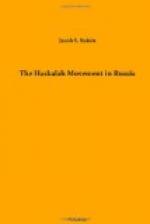Even among the conservative Talmudists signs of improvement were not wanting. The Gaon became the centre of a group of enlightened friends and disciples, who continued in his footsteps after his death. His son, Rabbi Abraham, who published and edited many of his works, a task requiring no small amount of acumen and Talmudic erudition,[12] was also the author of books on geography, mathematics, and physics. His pupils, such as Doctor Schick and Rabbi Benjamin and Rabbi Zelmele, influenced their contemporaries either directly, by bringing them in touch with the new learning, or indirectly, by reforming the school system and the method of Talmud study.[13] Of Rabbi Zelmele, who like his master became the hero of a wonder-biography written by his disciple Ezekiel Feivel of Plungian, we are told that he regarded grammar as indispensable to a thorough knowledge of the Bible and the Talmud, pleaded for a return to the order of study prescribed in the Pirke Abot, and complained that, owing to the neglect of Aramaic, the benefits of comparative philology were lost and unknown. He declared also that while he believed in all the Bible contains, the stories in the Talmud are, for the most part, legends and parables used for the purpose of illustration.[14]
[Illustration: MAX LILIENTHAL, 1815-1882]
Towering above all the disciples of the Gaon, the most outspoken in behalf of enlightenment is Manasseh of Ilye (1767-1831). At a very early age he attracted the attention of Talmudists by his originality and boldness. In his unflinching determination to get at the truth, he did not shrink from criticising Rashi and the Shulhan ’Aruk, and dared to interpret some parts of the Mishnah differently from the explanation given in the Gemara. With all his admiration for the Gaon, but for whom, he claimed, the Torah would have been forgotten, he also had points of sympathy with the Hasidim, for whose leader, Shneor Zalman of Ladi, he had the highest respect. Like many of his contemporaries, he determined to go to Berlin. He started on his way, but was stopped at Koenigsberg by some orthodox coreligionists, and compelled to return to Russia. This did not prevent his perfecting himself in German, Polish, natural




